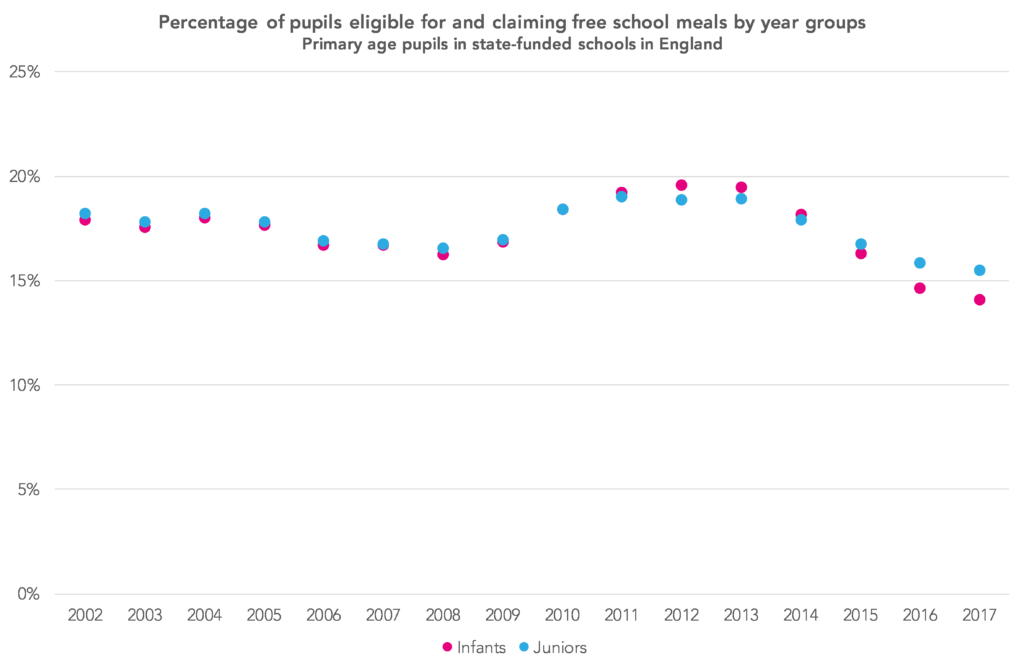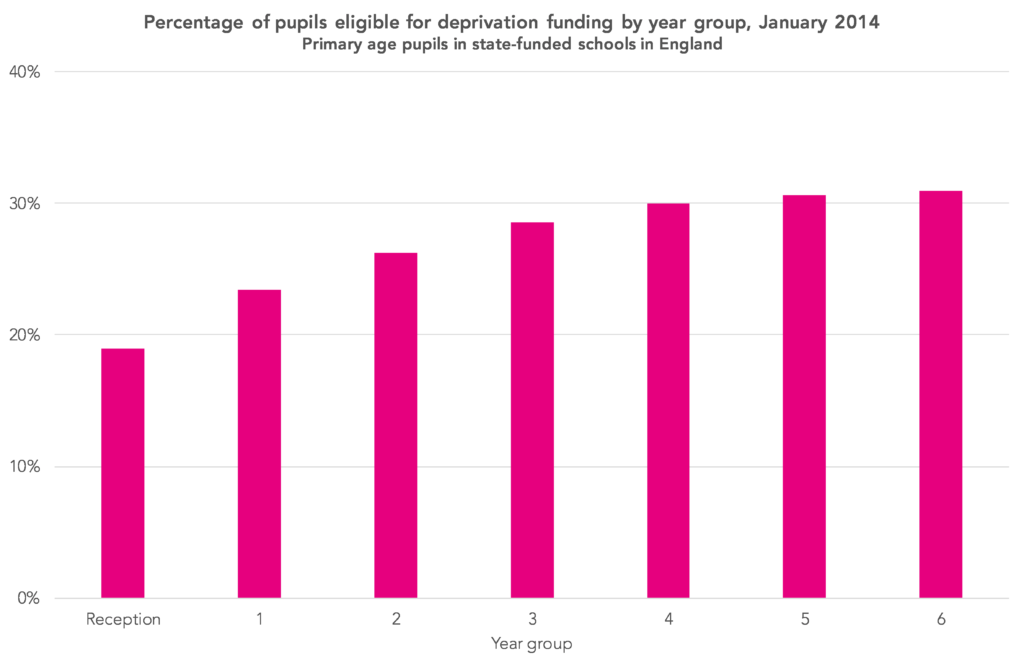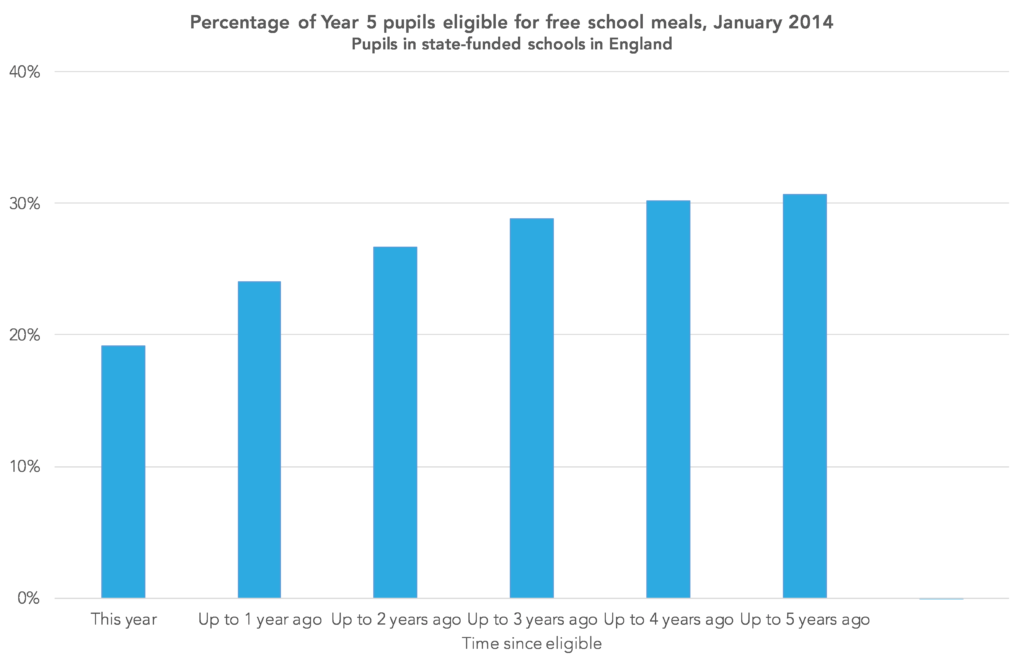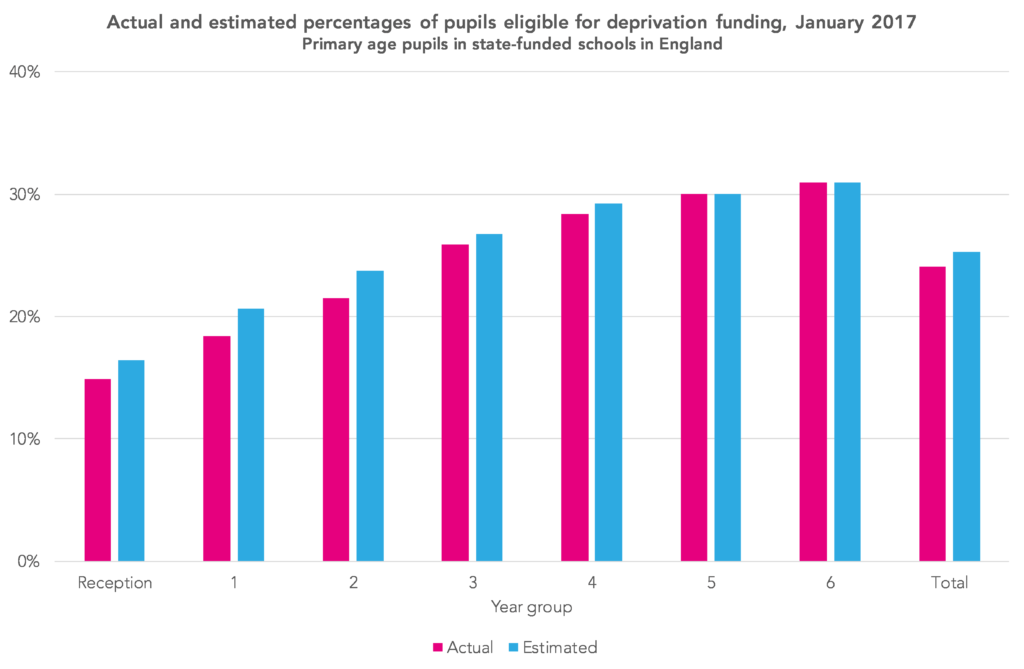In 2013/14, primary schools shared over one billion pounds in deprivation Pupil Premium funding. Based on the January 2013 school census, 1.1 million (27%) primary-age pupils were found to be eligible for deprivation Pupil Premium funding, on the basis for having been eligible for free school meals at some point in the previous six years. This equated to an extra £953 per eligible pupil.
By the 2017/18 academic year, the per pupil amount had risen to £1,320. There were still around 1.1 million eligible pupils in primary schools, so the total amount of funding had risen to £1.4 billion.
However, the total number of pupils had risen by half a million, meaning that the percentage eligible for deprivation funding had fallen to 24%. (As we wrote here, London is the region most affected.)
There are two reasons for this. Firstly, a general fall in free school meals eligibility, presumably due to changes in the economy and changes to benefit eligibility. Secondly, the introduction of universal infant free school meals (UIFSM) in September 2014.
How much funding are primary schools missing out on?
First a simple calculation. If the percentage of primary pupils eligible for deprivation funding in 2017/18 had remained the same as in 2013/14 – 27% – then an extra 137,000 pupils would have been eligible. At 2017/18 rates, this would have meant an additional £181 million in funding.
Now let’s try to separate out the impact of UIFSM from the general downward trend in free school meals eligibility. The chart below compares how the FSM eligibility rate has changed among pupils in the infant years (Reception to Year 2) and those in the junior years (Year 3 to Year 6).
As can be seen, the dots for infants start to fall below the dots for juniors from 2015, the first year of UIFSM.
So despite the best efforts of schools to collect evidence of eligibility for free school meals from the parents of infant children after the introduction of UIFSM, it appears that a small percentage of parents did not respond.
Estimating the impact of UIFSM
We need some sort of estimate of what the percentage of eligible pupils would have been in the absence of the UIFSM policy.
The first chart below shows the percentage of pupils in each year group eligible for deprivation funding in January 2014, before the introduction of UIFSM, while the second shows the percentage of pupils in Year 5 in January 2014 who were eligible for free school meals over different time intervals.
The pattern in the two charts broadly matches, as it does in the 2013 data. The significance of this is that we can use what we know about when pupils in Year 5 in January 2017 were eligible for free school meals to estimate what Pupil Premium eligibility would have been for younger pupils in January 2017 in the absence of the UIFSM policy.
The Year 5 group would have been the youngest cohort in 2016/17 not to have been affected by UIFSM. Using the relationship established in January 2014, we can use the percentage of pupils known to be eligible for free school meals during 2016/17 to give us an estimate of the percentage of Reception pupils eligible for deprivation funding. Similarly, the percentage of Year 5 eligible for free school meals in 2016/17 or the previous year gives us an estimate for Year 1 and so forth.
Doing this, the chart below shows actual and estimated percentages of pupils eligible for deprivation funding in January 2017.
In total, an extra 51,000 pupils might have been eligible for deprivation funding in 2017/18 – just over 1% of pupils. At the prevailing rate, this amounts to £67 million in funding.
And of course, the percentage of pupils eligible for deprivation funding fell further (to 23.3%) in January 2018 and so the amount of missing funding for 2018/19 would have increased.
Perhaps the total deprivation funding pot would have remained the same even if the Pupil Premium eligibility rate had stayed the same, in effect reducing the per pupil amount and spreading the jam a bit thinner.
But it does appear that some schools will be missing out on Pupil Premium funding as a result of universal infant free school meals. Not huge amounts of money, but enough for a few little extras.
Want to stay up-to-date with the latest research from FFT Education Datalab? Follow us on Twitter to get all of our research as it comes out.











Hi Dave, thanks for flagging this issue, however this only arises if local authorities have stand-alone claiming processes for administering FSM awards. In Leeds (not yet a full Universal Credit roll-out area), we have maintained a system of parents not needing to apply for free school meal eligibility as a stand-alone benefit. When adults make an application to the council for council tax support or housing benefit, if there are children in the household, the adults are also automatically assessed at the same time to check if they meet the eligibility criteria for free school meals for their children. Schools then receive a weekly email from our benefits service of who their eligible children are, so even in the universally eligible age groups, we believe there are very few instances of schools missing out on pupil premium funding, as a result of not knowing which families meet the FSM qualifying criteria. This works even where children are not yet school age, as each summer the benefits service use admissions data to identify the children who qualify and will be joining Reception so that schools know which of their incoming pupils are FSM eligible.
However we do still see the decline in eligible children that you have identified, because of welfare reform. The exclusion of working tax credit from the FSM eligibility criteria means that so many of the poorest families in Leeds do not qualify for FSMs. When we match indices of multiple deprivation data against FSM eligibility, even in the lower super output areas in our city that are in the 10% most deprived in the country, only 3 in 10 school age children quality for free school meals. I have worked with schools where siblings in the same family have different pupil premium statuses, because an older child had historic FSM eligibility in the previous 6 years, but younger children who have started school since welfare reform have never had any periods of FSM eligibility (almost always because of working tax credit) and so do not attract pupil premium funding.
There are only a few instances where we think schools could potentially miss out on pupil premium funding in the universally eligible age groups. This is where parents are liable for council tax in a neighbouring local authority (that does not operate the combined benefits application process like we do) but have children on roll in Leeds school; parents who don’t have rental or council tax liability (because they live with others or are homeless); or families applying for FSM eligibility for a child they are fostering rather than their own children. In these cases we do have a stand-alone FSM application form, but this forms a very small proportion of the overall benefits caseload.
Hi Becky. That’s an important point, thank you. As you say, LAs will be affected differentially depending on the FSM eligibility checking processes they have in place. The process you describe is no doubt why the %PP in primary at a national level hasn’t fallen by as much as some might have expected.